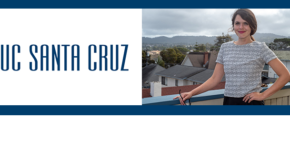 It’s hard to police everything that happens on the oceans.
It’s hard to police everything that happens on the oceans.
Heather Welch, project scientist at the University of California Santa Cruz, looks to help illuminate some of the issues faced in this endeavor.
Heather Welch is a project scientist at the University of California Santa Cruz, and is affiliated with the National Oceanic and Atmospheric Administration. She uses models to understand how the environment drives the movements of marine wildlife and resource users, and how these movements will change under climate change.
Illuminating Dark Fishing Vessels at Sea
The oceans are our modern-day Wild West – a vast expanse of water that’s challenging to surveille and police. Surveillance at sea is aided by the Automatic Identification System, or AIS, which are shipboard transponders that broadcast a vessel’s location. But unlike commercial airlines, which are required to keep their transponders on, fishing vessels can turn their transponders off, going dark and hiding their activities at sea.
We set out to explore where and why fishing vessels hide their activities. We found that AIS disabling obscured around 1.6 million hours of activity each year, which is concerning because we also found that vessels frequently go dark to obscure nefarious activities.
Fishing vessels disabled their transponders adjacent to Exclusive Economic Zones – which are geopolitical borders that delineate national and international waters. Vessels going dark near these boundaries are likely fishing without authorization. We found a disabling hotspot near Argentina, where authorities have captured and fined many foreign vessels for illegal fishing. In 2016, Argentina deliberately sank an illegal Chinese vessel as it fled toward international waters.
Fishing vessels also disabled their transponders in transshipment hotspots. Transshipment is the at-sea transfer of catch, people, and supplies between fishing vessels and refrigerated cargo vessels. When poorly monitored, it provides a means of laundering illegally caught seafood into the supply chain, and has been linked forced labor and human trafficking. We found a large disabling hotspot in the northwest Pacific, overlapping with a transshipment hotspot.
However, vessels can also go dark for legal reasons. Fishing vessels disabled to hide their locations from competitors, and to hide their positions in dangerous waters prone to piracy. While the act of AIS disabling itself doesn’t necessarily indicate illegal behavior, we find it’s a risk factor for unauthorized fishing and transshipments. This type of information can aid enforcement of our seas, the global commons we all rely on.
Read More:
[Science] – Hot Spots of Unseen Fishing Vessels

Comments
3 responses to “Heather Welch, University of California Santa Cruz – Illuminating Dark Fishing Vessels at Sea”